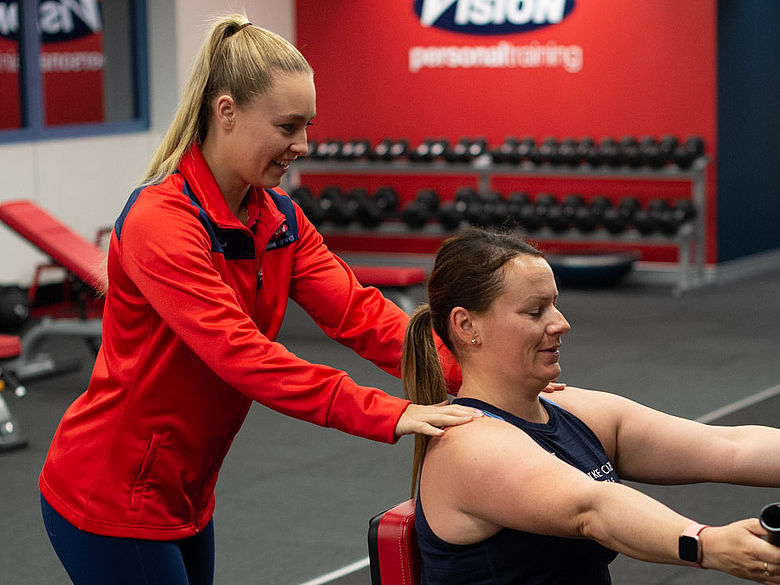As I write this article, the Gold Coast Marathon is approximately 11 weeks away! I hope that the training everyone is doing, for whichever race, (the 10km, 21km or the big 42km!) is going well and you're confident in your ability to cross that finish line.
Running is an amazing activity both from a cardiovascular and a musculoskeletal point of view, it gives the heart and lungs a killer workout and it engages all major muscle groups. Although it seems simple, running is actually a rather complex movement. The good news is, a number of other factors can be considered to assist your training and make running easier! Three things that can be added to your training program that will help to optimise performance and make your running as enjoyable as possible are regular strength work, mobility exercises and breathing control.
1. Importance of Strength Training
Running is a very repetitive motion and requires strength and stability to avoid injury. Two of the most common injuries for runners are muscle strains and tears, and stress injuries such as shin splints. Therefore, it is vital that we allow our bodies the best opportunity to withstand long distance running by increasing its capacity to handle the work being done. Regular glute, calf and hamstring specific strength work, as well as unilateral (single leg) training can prevent injuries by increasing the tolerance of those muscles to the load we put on them. Major exercises to include are deadlifts, squats, step-ups, incline (hill) or speed running sessions and leg press. Additional accessory exercises can also be included as activation prior to a run or as stabilisation exercises during a weights session, such as banded crab walks, clamshells, hamstring ball rollouts, calf raises and single leg glute bridges.
It's also important to work on postural muscles so we can remain upright and moving smoothly, particularly as fatigue sets in through the tail end of an event. As we tire, the tendency of the body is for the shoulders to roll forwards, the hips to collapse and a 'shuffling' motion to start. By activating your core muscles and mid-back, they'll work to brace the whole body against impact and posture will remain tall and relaxed, allowing for resisting fatigue, easy breathing and energy throughout the run.
2. Perks of Mobility Work
Flexibility and good mobility are important for everyday life, but particularly in long distance running. Tight muscles inhibit full range of motion (keeping you from running faster!), and can impact the body's ability to absorb force through the muscles, instead overloading the hip, knee and ankle joints. By including or increasing the amount of stretching and foam rolling in your weekly routine, as well as adding mobilisations for the feet, ankles and hips, it is easier to avoid common complaints such as plantar fasciitis, achilles tendinopathies, hamstring or calf strain, or knee pain.
Muscles to focus on are the hip flexors, glutes, quads, hamstrings and calves, as well as through the back and shoulders. Regular stretching or foam rolling is also a great recovery technique as it ensures that the muscles cool down properly after each session (combating muscle soreness).
3. Keep Breathing
Breathing control is a factor not often considered, especially in the initial phase of training. However, gaining control of your breath can have an enormous impact on your overall performance. Not only can proper breath control help with finding (and keeping) rhythm while you run, it can also brace the body and keep the shoulder and hip collapse mentioned earlier from happening. Additionally, learning how to expand your ribcage and brace with your diaphragm correctly means that you'll be much less likely to feel short of breath, as you'll be able to fill your lungs with oxygen and transfer it to energy for the run.
Something to try for yourself at home is 'diaphragmatic breathing'. Lying on your back with your hand on your stomach, bring your ribcage down to your hips and tuck your tailbone under so your abs are engaged and whole spine is in contact with the floor. Breathing in and keeping the abs switched on, focus on the breath coming into your stomach and feeling your belly rise and fall, rather than your chest. Incorporating 5 minutes of breathing like this a couple of times a week, especially before a training session, brings awareness to how the mid-section should feel over the course of a run. Once you've got the pattern whilst lying on the floor, move to standing and finally walking and running to see the change. Because this breathing technique allows for bracing of the entire midsection of the body, it results in more power through the hips and legs = stronger running!
Happy running, and see you on the Gold Coast!
*Disclaimer: Individual results vary based on agreed goals. Click here for details.
